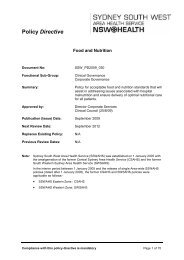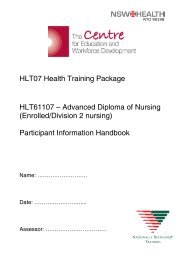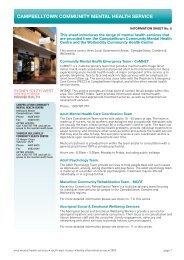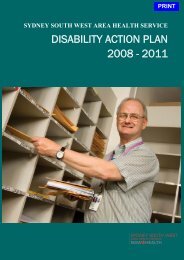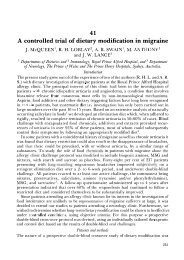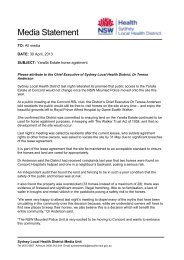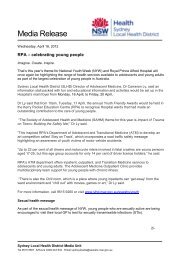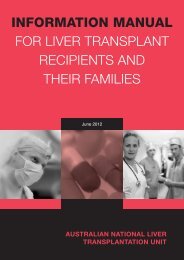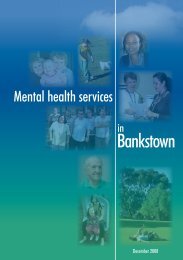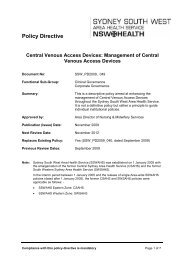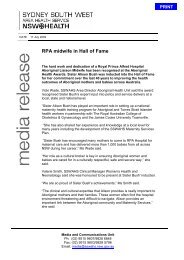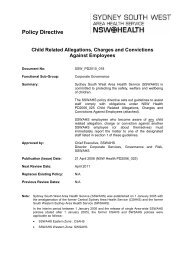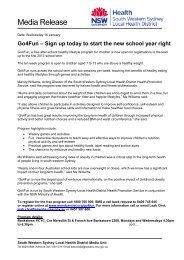Aged Care & Rehabilitation Clinical Services Plan 2007 – 2012
Aged Care & Rehabilitation Clinical Services Plan 2007 – 2012
Aged Care & Rehabilitation Clinical Services Plan 2007 – 2012
You also want an ePaper? Increase the reach of your titles
YUMPU automatically turns print PDFs into web optimized ePapers that Google loves.
<strong>Aged</strong> <strong>Care</strong> & <strong>Rehabilitation</strong> <strong>Clinical</strong> Service <strong>Plan</strong> <strong>2007</strong> - <strong>2012</strong>9.4 Access to Motor Vehicles, Patient Transport and Affordable/Accessible ParkingInpatient and community based AC&RS rely heavily on access to a fleet of vehicles to enable homevisits for discharge planning and assessment, and to provide treatment in the community. Asdomiciliary models of service (such as TACP) grow to relieve pressure on the hospital system, it willbe necessary concurrently to grow the motor vehicle fleet.Clients of AC&RS are those most likely to have mobility limitations and difficulty accessing publictransport. Many also rely on carers, who may themselves be ageing and have mobility limitations. Acritical aspect in the ability to provide care and support for these patients includes access tooutpatient treatment through clinics, day hospitals and community health centres. Access to respitethrough day care centres is also an essential component in the management and support of agedcare clients. To provide these services, adequate patient transport should be made available.Recommendation – Patient Transport <strong>Services</strong> and Affordable, Accessible ParkingIncrease access for AC&RS to appropriate transport services, including patient transport,accessible parking and fleet vehicles, to enable the delivery of centre and community basedservices9.5 GovernanceAt present AC&RS operate with two distinct governance models. Each model operates differently,through different management and staffing structures. In the eastern part of the Area, there is a<strong>Clinical</strong> Director responsible for all aged care and rehabilitation clinical services. In the south west,both aged care and rehabilitation services are managed by sub-specialty Directors, within theComplex <strong>Care</strong> and General Practice <strong>Clinical</strong> Stream.SSWAHS has reviewed the <strong>Clinical</strong> Stream structure, influencing the governance of AC&RS. In theshort term, an Implementation Management Committee has been established through the OlderPersons and <strong>Aged</strong> <strong>Care</strong> <strong>Services</strong> <strong>Clinical</strong> Redesign Project, to provide an Area wide governancestructure which can ensure corporate accountability requirements for AC&RS programs are met.This is essentially an expanded membership for the SSWAHS <strong>Aged</strong> <strong>Care</strong> Committee established in2006, to facilitate cooperation and collaboration across SSWAHS.It is anticipated that AC&RS will be grouped into three clusters: a Southern Cluster (Wingecarribeeand Macarthur areas), Central Cluster (Liverpool, Fairfield and Bankstown areas) and NorthernCluster (Canterbury, Concord and Camperdown areas). Clustering will be progressivelyimplemented.The new AC&RS structure will require the development of a comprehensive infrastructure to supportclinical governance and management. AC&RS will identify this structure in consultation with the AreaExecutive. The core functions of the AC&RS clinical stream will include clinical servicesplanning/networking, quality and safety/clinical governance, succession and workforce planning, andintegration of like departments across SSWAHS.Recommendation – GovernanceImplement the recommendations from the SSWAHS Review of <strong>Clinical</strong> Streams <strong>2007</strong>9.6 WorkforceFor SSWAHS, our workforce is an investment. An investment in the care of our community, aninvestment in the future sustainability of the care we need to provide to our community; and aninvestment in the individual and their career with us. The theme of the SSWAHS WorkforceStrategic <strong>Plan</strong> is “Investment in our Workforce”. The SSWAHS Workforce goal is to be the AreaHealth Service in which people want to work. In achieving this goal, there are four key tasks:• Secure, retain, develop, manage and support our workforce• Be a good place to work;• Offer opportunities to build a career with us; and• Ensure our workforce numbers and skills, and their tasks, location and mix, are sufficientto meet our service needs.Page 74




